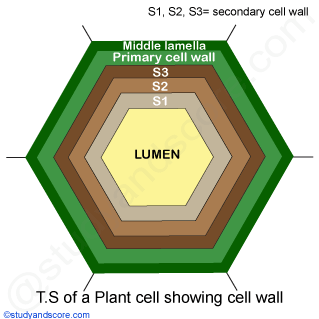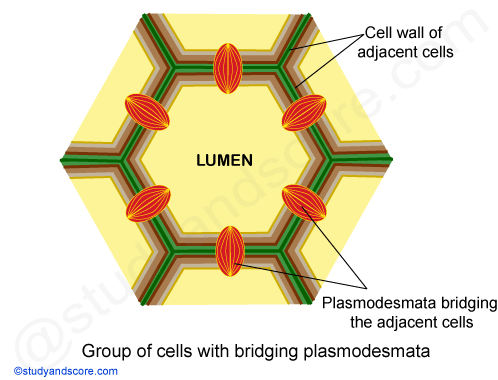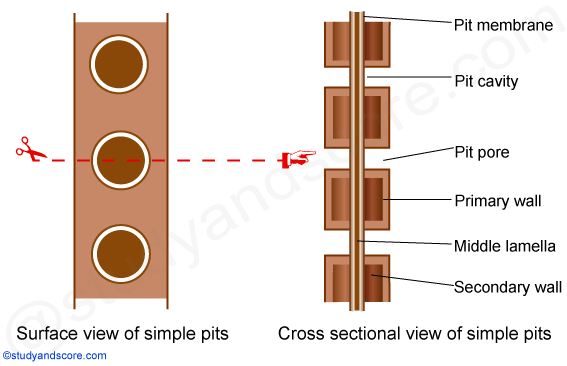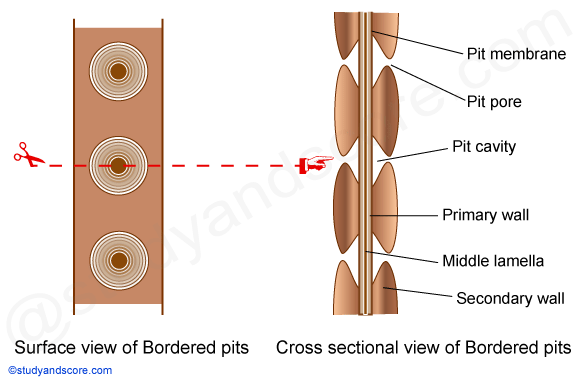Exceptionally, among the vascular plants certain cells connected with the reproductive processes, are naked and all the other cells have cell walls. Cell wall is protective layer in function and provides mechanical support to the cell. Cell wall determines the shape of the cells and any cell which has lost its cell wall becomes amorphic or in other words loses definite shape.
The cell wall was first observed by Robert Hooke in the year 1665 in cork cells of oak tree. Originally it was thought that the cell wall was a non-living secretion of the protoplasm, but now it is known to be metabolically active and is capable of growth.
A mature plant cell wall has the following three layers,
It is the outer most layer of the cell wall connecting the two adjoining cells like the cementing layer. Chemically it is composed of calcium and magnesium pectates. It is thin and amorphous layer. It is an isotropic or optically inactive layer of the cell. In addition to these substances proteins are also present in the middle lamellae.
It is the first formed layer of the cell wall during the cell division. The cell plate formed during the cytokinesis itself develops into the middle lamellum. Golgi complex plays an important role in the formation of middle lamellum. In multicellular organisms when middle lamellum dissolves, the cells get isolated from each other.
It is the layer present just under the inner side of middle lamella. It is thin, elastic and extensible in growing cells. Due the elastic nature of the primary wall, it helps in increasing the cell volume. It is anisotropic layer or optically active layer of the cell. Parenchymatous and meristematic cells possess only primary wall and no secondary wall.

Chemically primary cell wall is composed of cellulose, hemicellulose and pectin. A loose network of cellulose microfibrils embedded in a gel like matrix. The micro fibrils are oriented variously according to the shape and thickness of the wall. The matrix is mainly composed of water, hemicellulose, pectin and glycoprotein. Pectin is the filling material of the matrix. Hemicellulose binds the microfibrils with the matrix and the glycoproteins control the orientation of the microfibrils.
Certain thinner areas present in the primary cell wall are called as primary pit fields. In multicellular plants, cytoplasmic connections pass through these pit fields from one cell to other. These cytoplasmic bridges found between two cells are called plasmodesmata. Plasmodesmata help in intercellular transportation of cellular material from cell to cell.
The cell wall is interrupted by narrow pores carrying fine bridges of cytoplasm called as plasmodesmata. They form a protoplasmic band called symplast. It consists of a canal, lined by plasma membrane. It has a simple or branched tubule known as desmotubule. Desmotubule is an extension of endoplasmic reticulum. Plasmodesmata serve as a passage for many substances and they also have a role in the relay of stimuli.

After the cell has reached maturity, the cell wall may be thickened by addition of new layers. This thick wall is laid under the primary wall is called as secondary wall. Secondary wall is present between the primary wall and plasma membrane. It is the innermost layer of the cell wall. It is made up of three layers often named secondary wall layer 1 (S1), secondary wall layer 2 (S2) and secondary wall layer 3 (S3).
Chemically secondary wall is made up of a framework of cellulose microfibrils and interfibrillar spaces are mostly filled with lignin, suberin, pectin and cutin. Secondary walls are hard, tough and inelastic in nature due to the presence of wall materials like lignin. It is anisotropic layer or optically active layer of the cell.
It grows in thickness, layer by layer with the deposition of materials over the existing structures. The formation of secondary wall is not uniform in all the cells and this result in differentiation of various types of cells like parenchyma, collenchyma and tracheids. The areas in the secondary wall where wall material is not deposited are called pits.
Pits are the areas on the cell wall where secondary wall is not deposited. The pits of adjacent cells are opposite to each other. Each pit consists of a pit chamber and a pit membrane. The pit membrane consists of middle lamella and primary wall. Pit membrane has many minute pores and thus it is permeable.
Pits are of two types namely, simple pits and bordered pits.
Simple pits: In simple pits, usually the pit cavities are uniformly wide on all sides. The pit cavity is not enclosed by secondary cell wall.

Bordered pits: In bordered pit, the secondary wall bends like an arch over the pit, this gives a border like appearance and hence the name. The portion of the middle lamellum crossing the pits become thickened and is known as torus.

The Pits help in the translocation of substances between two adjacent cells. Generally pits develop in pairs. In other words, when a pit is present on the secondary wall of one cell, a similar or dissimilar pit will be present on the opposite side of the adjacent cell. Such type of pits form morphological and functional units called pit pairs.
| The Primary cell wall | The Secondary cell wall |
|---|---|
| It is formed in the growing cells | It is formed in the mature non-growing cells |
| It lies on the inside of the middle lamella | It lies on the inside of the primary cell wall |
| It is present in all the plant cells | It is present only in certain types of plant cells |
| Primary cell wall is elastic and flexible in nature | Secondary cell wall is rigid and non-flecible in nature |
| It consists of single layer of all material | It is formed of three or more layers |
|
Chemically it is composed of,
|
Chemically it is composed of,
|
| It is about 1-3µ in thickness | It is about 5-10µ in thickness |
| Cellulose microfibrils ae very loosely arranged | Cellulose microfibrils ae compactly arranged |
| Pits are formed in primary cell wall | Pits are formed in secondarycell wall |
| No additional material like lignin or suberin is found | Additional material like lignin and suberin is often found impregnated |
| Primary cell wall grows in thickness by the process of intussusception | Secondary cell wall increases in thickness by apposition |

- Share with your friends! -
Login to post your comment here...
- or with social Account -